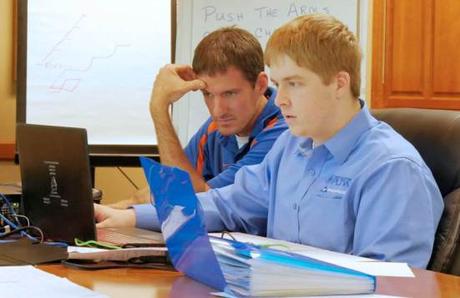(This article originally appeared in The Florida Times-Union at www.jacksonville.com.)

Engineer Bill Kane helps a student with load bearing formulas.
It was March, so it wasn’t surprising to see a group of young men discussing brackets.
But these weren’t the usual March brackets. The young men in question are engineering students at Palatka High School and they were double checking the math on load-bearing formulas.
Bill Kane, maintenance and reliability manager at Georgia-Pacific, was helping the group see that the current formula included misplaced brackets, changing the mathematical order of operations and providing the wrong answer.
This is what education should look like. When teacher Jan Boland recruited engineers from the local Georgia-Pacific plant to mentor students, neither she nor the GP staff knew what the mentors would actually do. When Kane, a mechanical engineer, suggested that the students design a monorail to move huge motors within a storage facility, the students jumped at the chance. “We’ve needed this system for a long time, but our engineers just didn’t have time to design it,” says Kane. “The monorail will cost us about $15,000 (the students did the material and cost estimating) and save us about $20,000 a year.”
The students have been working on the project since December 2015, meeting weekly with Kane. Their work is being checked and approved by the lead engineer at GP; in this session, the students discussed the merits of a stronger steel alloy he has recommended. They also spent time making sure they had the correct measurements of the wheel spans and had accounted for stress on the system from the side to side movement of the engines as they were loaded.
Teacher Jan Boland says that the students are part of Project Lead the Way, a national program that certifies teachers in STEM curricula such as engineering. Students take engineering and design courses over four years and must pass a national exam on engineering competencies. Boland is also assigning students to create a slide show about their project, which they’ll present to other classes in the hopes of recruiting more students. The current class started with 18 students; only four will finish this year. Only a handful of females students have participated in the program, something Boland would like to change.
Most of the young men plan to pursue engineering as a career. Avery will probably enroll in aerospace engineering at Iowa State, whose Ames, Iowa, campus felt warm and welcoming to the Palatka native. Jordan will pursue chemical engineering; Austin plans to get his associate degree from St. Johns River State College and go on to Florida Polytechnic University in Lakeland. Ron is undecided, but Daniel will head to the Recruit Training Program at Great Lakes near Chicago, after which he’ll enter the U.S. Navy’s nuclear operations program, one of the most academically rigorous in the armed services.
Terry Hadaway, GP’s public affairs manager, says that the company is working with the Putnam County Chamber to bring career mentoring into elementary and junior high schools. “Eighth grade, for example, is critical,” he says. “Students need to take rigorous courses earlier to prepare for programs like this when they enter high school.” GP has a vested interest in creating a pipeline of talent in the local community, he says. Finding talented engineers who are also connected and committed to Putnam County helps the company thrive in the long run. The students I observed were engaged and confident about solving tough problems; they’ll be an asset to any company lucky enough to hire them.
Find more information at pltw.org/engineering.

